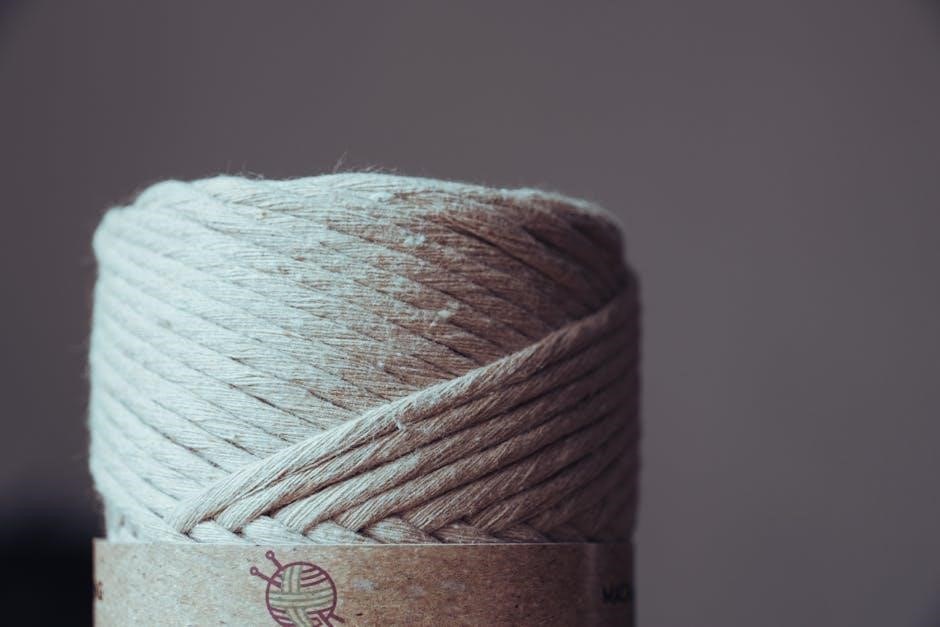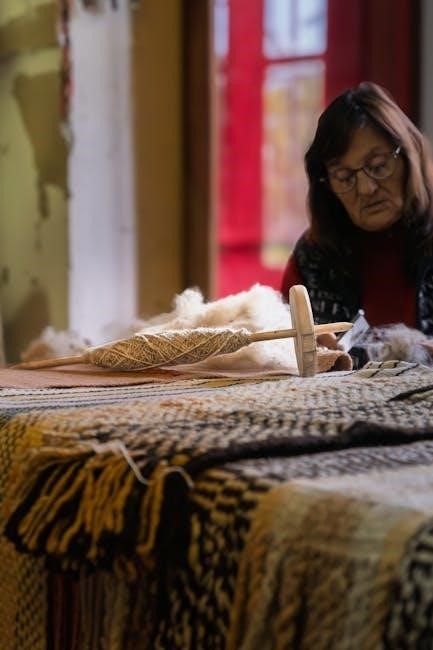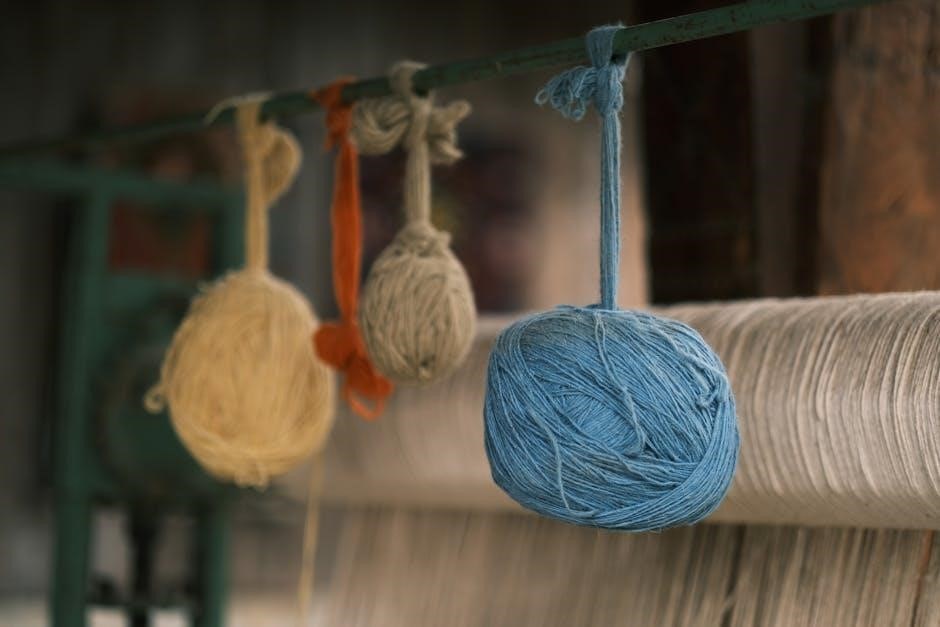Loom knitting is a versatile and accessible craft perfect for beginners. With downloadable PDF guides, you can learn essential tools, casting on, and basic stitches easily. Start creating hats, scarves, and more with step-by-step tutorials and free patterns designed for newcomers.
1.1 What is Loom Knitting?
Loom knitting is a method of creating knitted fabric using a loom with pegs instead of traditional knitting needles. It involves wrapping yarn around the pegs in a specific pattern and then pulling it through to create stitches. This technique is great for beginners, as it simplifies the knitting process and allows for quick, versatile projects like hats, scarves, and blankets. Free PDF guides and tutorials make learning easy and accessible for everyone.
1.2 Benefits of Loom Knitting for Beginners
Loom knitting offers numerous benefits for beginners, including simplicity, portability, and quick results. Unlike traditional knitting, loom knitting requires minimal equipment and is easier to learn, making it ideal for those new to knitting. The ability to create a variety of projects, from hats to scarves, with step-by-step PDF guides and video tutorials, ensures a smooth and enjoyable learning experience for all skill levels.
Essential Tools and Materials for Loom Knitting
A knitting loom, yarn, loom hook, yarn needle, scissors, and measuring tape are the primary tools. Choose yarn based on weight and project size, ensuring compatibility with your loom’s peg count for best results.
2.1 Types of Knitting Looms (Round, Long, Rectangular)
Round looms are ideal for hats, socks, and circular projects. Long looms suit scarves and flat panels, while rectangular looms are great for blankets and large items. Each type offers various peg counts, allowing flexibility in project size. Beginners can start with a round loom for small, quick projects like beanies, ensuring a smooth learning curve and immediate results.
2.2 Yarn Selection for Beginners
Choose yarn that suits your project and skill level. Acrylic and blends are ideal for beginners, offering softness and ease of use. Worsted weight yarn is recommended for most loom knitting patterns. Consider fiber type, color, and texture to achieve desired results. Ensure yarn is not too thick or too thin for the loom pegs. Always check the yarn label for gauge and care instructions.
2.3 Accessories (Loom Hook, Yarn Needle, Scissors)
Essential accessories for loom knitting include a loom hook, yarn needle, and scissors. The loom hook helps move loops and secure stitches. A yarn needle is used to weave in ends. Scissors are necessary for cutting yarn. These tools ensure smooth progress and professional finishes; Keep them handy to streamline your knitting process and maintain neat, tidy work.

Basic Techniques for Loom Knitting
Mastering basic techniques like casting on, garter stitch, and single knit stitch is fundamental. These steps form the foundation of loom knitting, making it easy to learn and progress smoothly.
3.1 Casting On: Step-by-Step Guide
Casting on is the first step in loom knitting. Begin by securing the yarn to the edge peg. Then, create a slipknot and place it on the first peg. Bring the yarn behind the loom and loop it around each peg in sequence. Tug gently to secure each loop, ensuring even tension. This sets the foundation for your project.
3.2 Basic Stitches (Garter Stitch, Single Knit)
The Single Knit stitch is created by knitting one peg at a time, moving the yarn from front to back. The Garter Stitch involves knitting two rows, then purling two rows, creating a textured pattern. Both stitches are versatile and ideal for beginners, allowing you to practice basic techniques while creating simple, elegant designs for hats, scarves, and more.

Patterns and Projects for Beginners
Start with simple projects like hats, scarves, and baby items using free PDF patterns. These easy-to-follow designs are perfect for practicing basic stitches and techniques.
4.1 Simple Hat Pattern Using a Round Loom
Create a cozy hat using a round loom with a simple pattern. Choose medium-weight yarn for a snug fit. Cast on evenly, knit rows using garter or single knit stitches, and bind off loosely. Follow step-by-step PDF guides for sizing and shaping. Perfect for practicing basic techniques and achieving a quick, satisfying project. Great for all skill levels and gift-giving.
4.2 Scarf and Blanket Patterns
Scarf and blanket patterns are ideal for practicing length and texture. Use a rectangular loom for scarves or a round loom for blankets. Start with simple stitches like garter or single knit. Free PDF guides offer step-by-step instructions for various styles. Choose lightweight yarn for scarves or thicker yarn for cozy blankets. These projects are great for mastering stitch consistency and color changes while creating functional items.
Binding Off and Finishing Techniques
Mastering bind-off and finishing techniques ensures a polished look for your projects. Learn basic methods, secure loose ends, and add decorative borders for a professional finish.
5.1 Basic Bind-Off Methods
Basic bind-off methods are essential for completing your loom knitting projects neatly. The standard bind-off involves lifting loops from the pegs and securing them. Use a yarn needle to weave in ends. For a stretchy finish, try the elastic bind-off. Detailed PDF guides and video tutorials provide step-by-step instructions for these techniques, ensuring a professional finish every time.
5.2 Adding a Border or Edging
Adding a border or edging enhances your project’s appearance and provides a polished finish. Use basic stitches or textured patterns to create decorative edges; Step-by-step instructions in PDF guides and video tutorials help you master these techniques. Choose complementary yarn colors and patterns to customize your designs, ensuring a professional and personalized touch for scarves, hats, or blankets.

Tips for Reading Loom Knitting Patterns
Understand pattern abbreviations and symbols to follow instructions accurately. Practice reading charts and row-by-row guides to master stitch sequences and tension control for consistent results.
6.1 Understanding Pattern Abbreviations
Pattern abbreviations are essential for efficient knitting. Common terms include CO (cast on), BO (bind off), and Knit. Familiarize yourself with these to decode instructions quickly. Always refer to the provided glossary or guide for clarification. Understanding abbreviations ensures accurate stitch execution and helps you follow complex patterns with confidence. Keep a reference handy to avoid confusion and maintain consistency in your projects.
6.2 Following Stitch Instructions
Accurately following stitch instructions is crucial for successful loom knitting. Start by reading the pattern thoroughly and identifying specific stitches like garter or single knit. Use tutorials or PDF guides to visualize techniques. Pay attention to sequence and tension to maintain consistency. Practice step-by-step, referring to video tutorials if needed, to master each stitch and ensure your project turns out as intended.

Common Mistakes and How to Fix Them
Tight or loose stitches can ruin projects. Fix by adjusting yarn tension or reworking rows. Dropped stitches can be picked up with a yarn needle gently.
7.1 Avoiding Tight or Loose Stitches
Tight or loose stitches can ruin your project’s texture. To avoid this, ensure even tension while knitting. Gently tug the yarn after each stitch to maintain consistency. If stitches become too tight, try loosening your grip. For loose stitches, pull the yarn slightly firmer. Practice on swatches to find the perfect balance for elastic, professional-looking fabric.
7.2 Fixing Dropped Stitches
Dropped stitches can be frustrating but are easily fixed. Use a yarn needle to carefully pick up the dropped stitch and reposition it onto the peg. Work row by row to ensure alignment. For multiple dropped stitches, gently unravel to the error point and reknit. Regularly checking your work helps prevent mistakes and ensures a smooth, professional finish every time.
Free Loom Knitting Resources and Tutorials
Explore free PDF guides, video tutorials, and downloadable manuals for beginners. Resources like the Knifty Knitter manual offer step-by-step instructions, making learning easy and accessible for all skill levels;
8.1 Downloadable PDF Guides
Downloadable PDF guides provide comprehensive instructions for loom knitting. These guides cover tools, cast-on methods, basic stitches, and finishing techniques. Resources like the Knifty Knitter manual and Good Knit Kisses offer step-by-step lessons, perfect for beginners. They often include photos and practice exercises, ensuring a smooth learning experience. These free PDFs are readily available online, making it easy to start your loom knitting journey with confidence and clarity.
8.2 Video Tutorials for Beginners
Video tutorials are an excellent resource for learning loom knitting. Platforms like YouTube offer step-by-step guides, covering basics like casting on, stitches, and binding off. Tutorials often include close-ups and clear instructions, making complex techniques easy to follow. Many PDF guides, such as the Good Knit Kisses series, include links to complementary video content, ensuring a comprehensive learning experience for newcomers.
Advanced Techniques for Beginners to Explore
Explore cables, texture stitches, and multi-color projects to enhance your loom knitting skills. These techniques add complexity and creativity to your work, offering new challenges and results.
9.1 Cables and Texture Stitches
Cable and texture stitches add complexity to your projects. Using PDF guides, learn to create intricate cable patterns and textured designs. These techniques involve manipulating stitches to form visually appealing fabrics. With practice, you can achieve professional-looking results, enhancing your projects’ uniqueness and sophistication. Start with simple cables and gradually explore more complex textures for a rewarding knitting experience.
9.2 Working with Multiple Colors
Working with multiple colors enhances your projects’ visual appeal. Use contrasting yarns to create stripes or patterns. Change colors at the end of a row for a seamless transition. Carry unused yarn loosely to avoid puckering. Weave ends with a yarn needle for a clean finish. Practice colorwork on scarves or blankets for a vibrant, professional look.
Congratulations on mastering the basics! Explore advanced techniques, download free PDF guides, and try new projects. Join knitting communities for inspiration and continued growth in loom knitting.
10.1 Encouragement to Keep Practicing
Celebrate every small victory and enjoy the creative process. Loom knitting offers endless possibilities, from hats to blankets. With each project, your skills will grow. Don’t hesitate to explore free PDF guides and video tutorials for inspiration. Remember, practice is key, and the knitting community is always here to support you. Happy knitting!
10.2 Suggested Projects for Further Learning
Move beyond basics with scarves, blankets, and baby items. Try a cardigan or jacket for a challenge. Explore free PDF guides and video tutorials for inspiration. Each project builds skills and confidence. Join the knitting community to share creations and discover new ideas. Keep exploring and enjoy the journey of mastering loom knitting!
